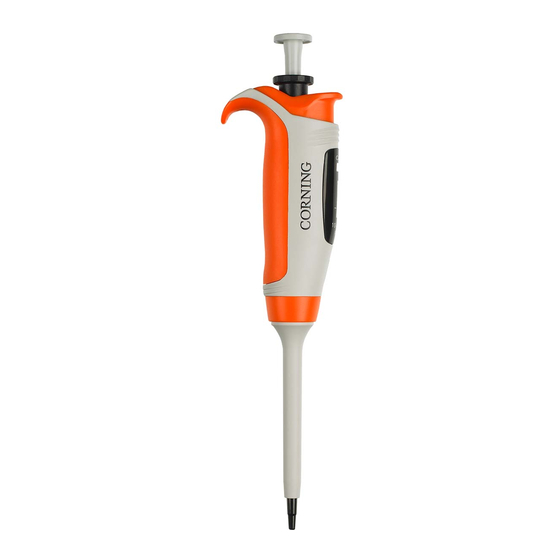CORNING Lambda EliteTouch Інструкція з експлуатації - Сторінка 7
Переглянути онлайн або завантажити pdf Інструкція з експлуатації для Лабораторне обладнання CORNING Lambda EliteTouch. CORNING Lambda EliteTouch 17 сторінок. Single-channel, 8-channel, and 12-channel pipettors

Aspirating High-density Liquids
When pipetting liquids of higher viscosity or lower surface
tension than water (e.g., sera or organic solvents), a film of
liquid is formed on the inside wall of the pipet tip. This film
can create an error. As the film remains relatively constant in
successive pipetting operations with the same tip, this error
can be eliminated by forming the film before transferring
the first sample. This is done by aspirating a sample and
dispensing it back into the same vessel. Now, as the film is
already formed, all of the following samples will have better
accuracy and repeatability.
This pre-rinsing operation should be repeated when
the volume to be aspirated is changed or when a new pipet
tip is used.
NOTE: Normally the degree of error resulting from heavy or
viscous liquids is negligible if pipetting is done slowly and
carefully. It is most important to give the liquids some time
to react to the change of pressure by holding the pipet tip
in its position for at least 2 seconds after the aspiration and
the blow out stroke.
If in extreme cases, this method of operation does not result
in accurate values, recalibrate the pipettor out in accordance
with Section 9.
After calibration, it is recommended to record the recalibration
and the size of the correction introduced, to facilitate
reverse calibration to the standard liquid.
9. Checking Pipetting Accuracy Parameters
and Pipettor Recalibration
The pipettors are factory-calibrated using the gravimetric
method with Corning® pipet tips and distilled water, in
accordance with ISO 8655 guidelines for the maximum
(nominal) liquid volume drawn by the pipettor and for 10%
of the maximum volume according to the values given
(Section 5).
The design of the pipettors enable their recalibration
and adaptation to other pipetting techniques or liquid
properties (i.e., temperature, density and viscosity).
It is recommended to carry out periodic checks of the
operation of the pipettor at least once a year, the period
of operation of the pipettor with no checks depends
on the type of workload (liquids collected), and other
conditions (load intensity and sterilization in the autoclave,
replacement of components) in which the pipettor is used.
If during pipettor operation you find that the accuracy error
(the difference between the real aspirated volume and
10 – Corning Lambda EliteTouch Pipettors
the preset volume) exceeds the permissible value given
in the table in section 5, the pipettor recalibration procedure
should be carried out.
Recalibration of the pipettor consists in setting on the counter
the value of the liquid volume obtained in weighing.
Recalibration of the pipettor is performed only for one liquid
volume drawn by the pipettor. The recommended volume
for recalibration is 10% of the maximum (nominal) value.
Conditions for Checking the Pipetting Accuracy Parameters
The pipetting accuracy is influenced by such factors as:
tips used, characteristics of the pipetted liquid (density,
viscosity), or operating conditions (ambient temperature,
pressure).
To determine the accuracy error of the pipettor, the following
conditions should be met:
• Ambient temperature and the temperature of the
pipettor, pipet tips, and liquid should be within the range
of 20°C to 25°C and stabilized during weighing within
±0.5°C.
• Measurements should be conducted using distilled water.
• Balance sensitivity should be suitable for the volume "V"
to be measured:
Volume Checked
(μL)
0.1≤V≤ 10
10≤V≤100
V>100
• When calculating the liquid volume aspirated by
the pipettor, the values of conversion factor Z [μL/mg] for
distilled water or a liquid with comparable density should
be taken into account. Sample values of this conversion
factor are given in the following table:
Temperature
(°C)
95.0
20
1.0028
21
1.0030
22
1.0032
23
1.0034
24
1.0037
25
1.0039
Balance Sensitivity
(mg)
0.001
0.01
0.1
Pressure (kPa)
101.3
105.0
1.0029
1.0029
1.0031
1.0031
1.0033
1.0033
1.0035
1.0036
1.0038
1.0038
1.0040
1.0040
INSTRUCTION MANUAL – 11
